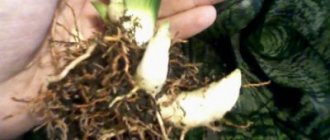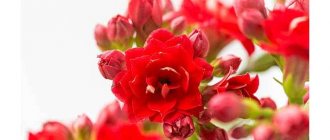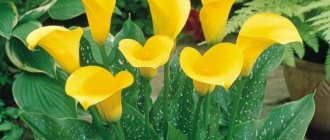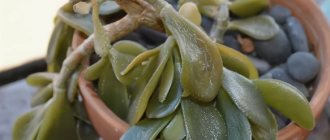Plants are a wonderful addition to home decor. However, you need to remember that all plants may require special care. They, just like pets, should never be forgotten. They need to be watered, the soil or soil changed, the ends trimmed, etc. In the same article you will learn about what care at home is required for such a beautiful plant as Sansevieria.
General rules"
If you decide to buy yourself such a wonderful new member of the household, then you should definitely know (so as not to be confused) that Sansevieria has several names. You can get to know them:
- Pike tail.
- Snake skin.
- The tongue of the devil.
- Leopard lily.
- African hemp.
- Indian sword.
- Cuckoo's tail.
- Sanseviera.
- Sansevieria.
- Sanseviera.
This number of names is definitely impressive.
Interesting! If Sansevieria appears in your home, it means it’s time to implement something you’ve been planning for a long time, since the pike tail flower symbolizes good luck.
Now you need to understand the important qualities of a houseplant that you may need to determine the proper care of sansevieria at home:
- The most valuable part of piketail as an ornamental plant is the leaves. They have a lanceolate shape and extend upward from a strong root.
- The leaves can reach a height of 1 meter, but it happens that they are even higher.
- Leaves can be of different colors. The most common colors are dark green and brown. Yellow and silvery leaves are less common.
- They may have various decorations (not in our usual understanding, of course). This can be edging and various types of stripes.
It may seem to you that these are not the most necessary facts, but every pike tail lover should also be familiar with it.
Pests
Spider mite
The insect reveals itself by the appearance of whitish spots on the leaves. The pest feeds on the juices of the plant, so it gradually withers and, after a while, dies. If the damage is in the initial stage, to save the sansevieria, you can wipe its leaves with a cloth dipped in an infusion of citrus peel. If the plant is severely damaged, it is worth resorting to the help of insecticidal preparations.
Thrips
Colonies of pest larvae are localized mainly on the lower part of the leaves, so that is where they can be found. Light spots are visible on the upper side of the leaf. The leaf acquires a characteristic grayish-brown tint and a silvery sheen . As a treatment, the plant is repeatedly treated with insecticides.
Mealybug
The pest settles at the base of the leaf rosette and feeds on the sap of the plant. Symptoms of the lesion are cotton wool-like lumps - a waste product of the insect, which it leaves on the leaves. Infected areas may also change shape and color.
If the damage is severe, resort to insecticides.
Shchitovka
The parasite feeds on the sap of young plants and their shoots. You can find its eggs on the back of the leaves . Parasites are removed using a swab dipped in a strong soap solution, followed by treatment with an insecticidal preparation.
What are the benefits of Sansevieria?
Surely, if you decide to take care of sansevieria at home, then you know why you need this flower. However, we decided to remind you of some beneficial properties of leopard lily:
- Natural filter for ambient air.
- If you keep it at home, you can be sure that your home will be oxygenated and free from harmful elements.
These are the most important qualities of the pike tail for which it is famous.
Important! In fact, Sansevieria is a completely unpretentious plant. In order to care for him, you only need to know a few things.
Now pay attention to some aspects of caring for sansevieria at home:
- When choosing a pot for a flower, make sure that it is thick-walled, since the roots of the plant are thick and they can easily break your pot.
- Follow the light. With a lack of light, the leaves fade, and with too much light, they turn yellow. Also, do not forget about winter supplementary lighting.
- Water the flower with rain or gently settled water. The procedure is carried out as the soil dries, less often in winter.
- Feed the plants twice in the summer.
- If possible, it is best to keep the pike tail at a temperature of 14 degrees or so. Drafts or sudden changes in temperature are strictly contraindicated.
- A good tip is to wipe the leaves of Sansevieria with a damp cloth, this will dramatically reduce the likelihood of spider mites appearing.
- To understand whether the plant has enough light, pay attention to the leaves. They always give signals. If they stretch out and droop, this is a sure sign that the plant is not receiving enough light.
- As already mentioned, you should not water sansevieria too often, otherwise the leaves will turn yellow and dry out.
These are the basic rules for caring for sansevieria at home, which must be followed constantly for the plant to feel good.
Pike tail diseases with photos
Why do leaf problems occur?
First of all, with various diseases, the leaves of the plant begin to change.
Curl up
The cause of this symptom is most likely a lack of moisture in the soil. Sansevieria does not like frequent watering , but it still needs to be done regularly. It is enough to restore the optimal substrate moisture regime for the flower and the leaves will again acquire a healthy appearance.
Wrinkled
If sansevieria is left for a long time in conditions of insufficient light and without watering, the result will be wrinkled leaves. If this happens to the plant, you must first carefully correct the light regime - gradually moving the pot from partial shade to the southern window sill and adjust the watering regime.
Are falling
If a plant's leaves are falling off, it is most likely cold. Failure to comply with the temperature regime is fraught with the death of the flower , therefore, if you find such a sign in sansevieria, you should urgently move it to a warmer room.
Become lethargic
Limp, rotting leaves are a sign that the room temperature is too low. The plant must be urgently moved to a warmer place, after removing all damaged leaves.
Does not develop well or does not grow at all
Also, the flower may stop growing due to too frequent watering. If Sansevieria stubbornly does not want to grow, the way out of the situation is to transplant it into a smaller pot and water it no more than once every two to three weeks.
The plant withers and turns yellow
Fading yellow leaves are a sure sign that the plants are overcrowded and lacking water. This symptom also often appears in flowers placed close to heating appliances. In order to help sansevieria in this case, you need to remove excess leaves , including those that have withered or turned yellow, and adjust the watering regime.
Fungus
Sansevieria is susceptible to several types of fungal diseases, including Fusarium spot and rhizome rot.
Fusarium spot
It appears in the form of small watery spots, appearing more often on young leaves. As the disease progresses, the spots grow and take on an elliptical shape, turning reddish in color. Subsequently, a yellow border forms around the spots. If the lesions are extensive, they join together and cause the death of the plant.
The development of the disease is provoked:
- excess air and soil humidity;
- a large amount of nitrogen in the soil;
- high temperature with insufficient ventilation.
Infection can be avoided by maintaining the correct conditions of detention; treatment is carried out through repeated treatment with fungicidal preparations.
Rhizome rot
It is almost impossible to cure this disease, so all efforts must be directed towards prevention, namely, to prevent excessive soil moisture (read about what the soil for sansevieria should be like here).
Sansevieria transplant
Of course, one of the most important aspects of caring for sansevieria at home is replanting. The plant needs to be replanted once every 2-4 years, preferably in March-April, since usually at this time powerful roots begin to fill the entire thick-walled pot and are already beginning to protrude from its upper part. When replanting, it is necessary to take into account the composition of the soil: peat, sand, leaf soil and humus.
For those who do not perceive such information well in printed form and often forget various nuances, you can use a video that will clearly show you how to carry out this simple procedure.
How to propagate Sansevieria at home
Reproduction is possible by dividing rhizomes, leaves or lateral shoots, as well as seeds.
When dividing the rhizome, it is cut with a sharp knife so that each part has its own growing point. Plant each fragment in a separate pot and place it in a warm place, providing moderate watering.
When dividing a leaf, you need to divide it into parts 4-5 cm long, hold them in the air for a short time and place the lower end of each in sand (at an angle of 45°). Next, you need to cover each fragment with a bottle or jar and place it in a warm and bright place without direct sunlight.
Bloom
Many people who want to buy a pike tail have a question: does this beautiful plant even bloom? In fact, Sansevieria rarely blooms, but there are special conditions that help the plant bloom. They have already been mentioned above, but I would like to pay special attention to some.
Firstly, it is good lighting, but do not forget that excess light will also not be the best option for favorable flowering of the plant. Secondly, this is proper care, that is, compliance with all the rules that were described above. Thirdly, fresh air, but remember that drafts harm the pike tail.
For flowering to occur, window sills of southern, western and eastern orientation are best suited. In winter, light can be compensated by “additional illumination,” that is, artificially created illumination.
If you want to understand how to determine whether a plant is blooming or not, then pay attention to whether your plant has sent out an oblong arrow. The small flowers that accompany the flowering of Sansevieria look simply charming against the background of dark green leaves.
They resemble a lily flower. This is probably why Sansevieria has the name “leopard” lily. They smell delicious, but their smell will not be intrusive, it is light and gentle. Mostly flowers bloom in the dark. Most often, the plant blooms in the warm season, mainly in the summer.
Note! With proper care and good lighting, the plant can begin to bloom even in the spring, in April or May.
But each rosette can bloom only once in its entire life. Intense flowering lasts for five to seven days.
Is it possible to keep mother-in-law's tongue in the house?
Most areas of esotericism and eastern philosophies classify the flower as friendly to humans. According to the ancient philosophy of Feng Shui, all plants with leaves that point upward and have positive energy bring success to the owner.
According to another assumption, a flower with succulent and fleshy leaves accumulates negative energy and emotions of household members. If there are several such plants in the house, the positive effect increases. Many gardeners note the beneficial effects of:
Is mother-in-law's tongue poisonous or not?
The effect of air purification is achieved through compounds called saponins. In small concentrations the substances have disinfectant properties. In folk medicine it is used in the form of lotions and decoctions:
However, eating the leaves raw can cause poisoning, burning in the mouth, and lacrimation. Compliance with safety rules is important when transplanting a flower; all operations must be carried out with gloves.
Plant species
In addition to the fact that this plant goes by many names and names, it also has many different species. Depending on what exactly you want to purchase, you choose for yourself which flower will bloom in your home, enrich your air, saturate the house with oxygen.
Types of Sansevieria:
- Sansevieria Three-striped , also known as Laurenti. A very large plant. It was mentioned above that Sansevieria grows up to a meter or more. So, it is Laurenti who usually grows above a meter. But on average her height is from thirty to sixty meters. Its leaflet is flat and sword-shaped. The rosette is formed from six powerful, striped leaves. Lighting has a special influence on the color of leaves. The more the plant receives it, the brighter its longitudinal stripes on the leaves. You can find this type of pike tail in offices, kindergartens, schools and other government and children's institutions.
- Nelson . Formed (hybrid) from the above described Laurenti species. The leaves of this type are thick and, like many others, dark green. Their length is generally 20-30 cm. Most of all they are known for their density of growth. However, Nelson is growing extremely slowly.
- Compacta . Small Laurenti is called compact. Almost completely matches the appearance of its ancestor, only smaller in size (about 30 cm).
- Cylindrical . This type of sansvieria can rarely be found in homes, as it is considered very exotic and is distinguished by its beauty. Height is from 40 to 150 cm. Its peculiarity is that it is absolutely unpretentious to lighting. The leaves have natural flexibility. Despite the fact that she herself is unpretentious to light, flowering occurs with sufficient lighting.
- Pickaxe . Its leaves resemble shells or ruffles. They are covered with abundant speckles, their color is green or slightly brownish (pinkish). When it blooms, it emits a wonderful delicate aroma. Captivates everyone and attracts everyone's attention
- Liberian . The leaves of this species are arranged horizontally, which greatly distinguishes this type of Sansevieria from others in which the leaves are directed upward.
- Graceful (graceful) . The houseplant resembles an agave.
In addition to these main seven species, there are others that you can find much less frequently: Duneri, Hyacinth, Big, Moonshine, Hunny, Hunny Gold, Hunny Silver, Sensation Bentle, Futura, Robusta, Silver Queen, Twisted Sister.











